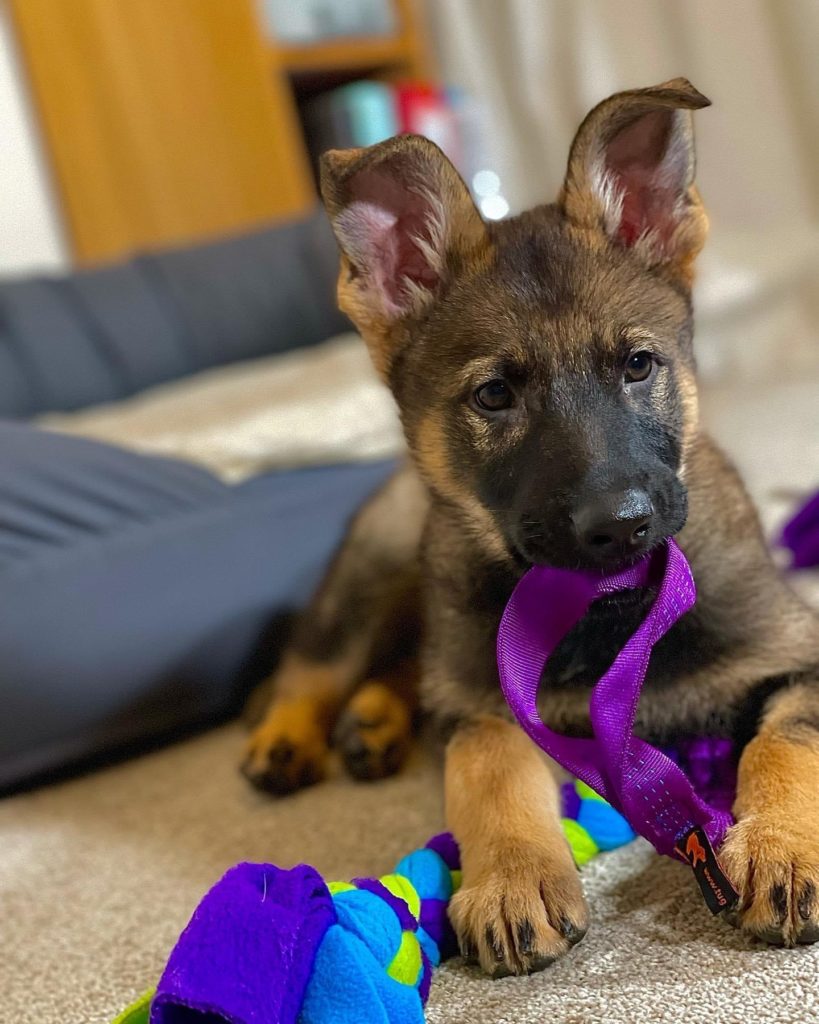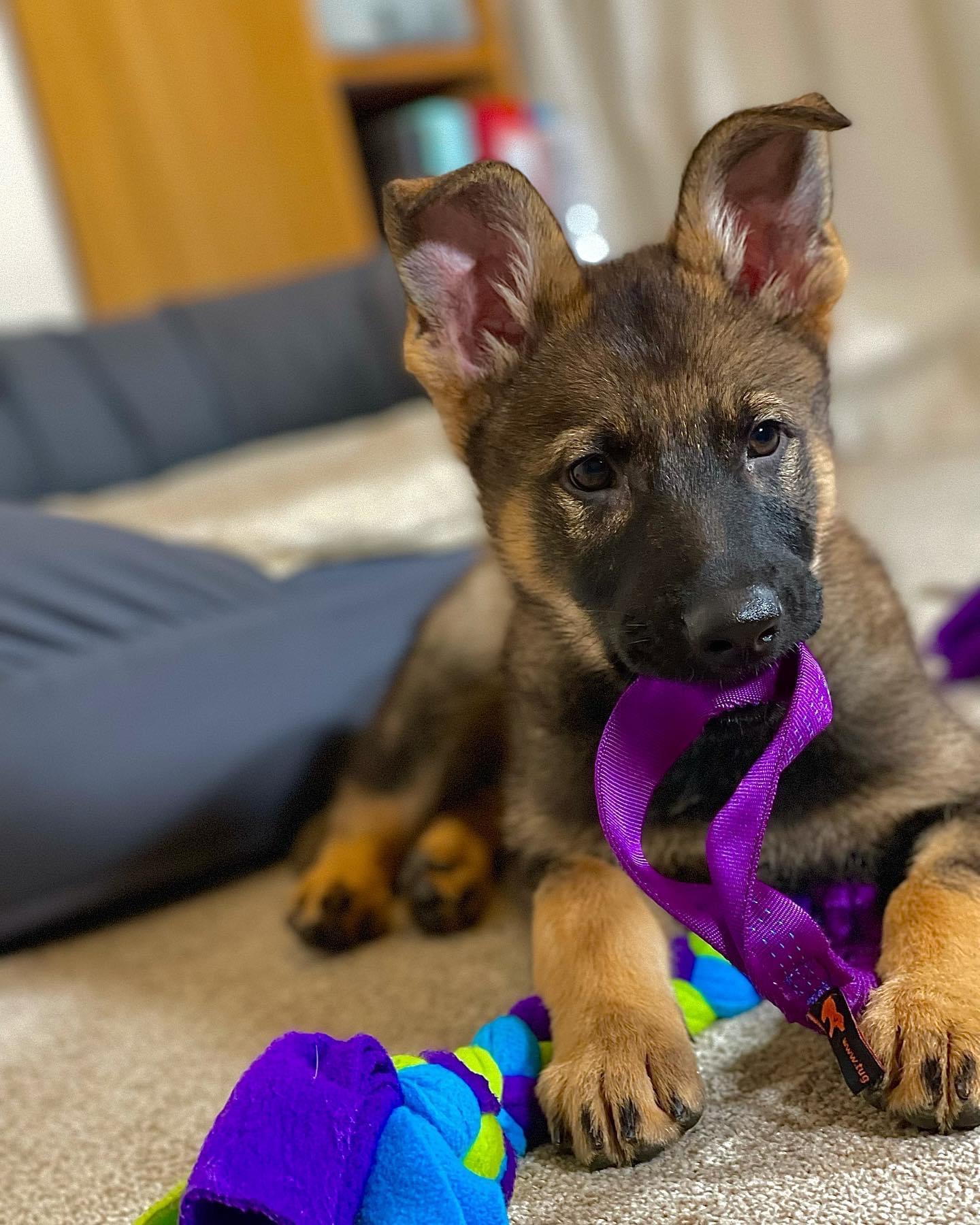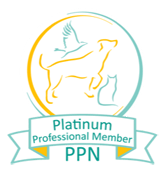
We are excited to welcome our working line German Shepherd puppy
Having been looking for a long time, we finally found a breeder we were happy with and who had dogs we liked. Why did we want to buy a puppy from a breeder, you might ask.
Having owned both rescues and dogs from breeders, I was looking for a specific line of German Shepherd with a high drive and suitable ‘working type’ genes. I hope to compete with him over the next few years, so keep an eye out for all his progress.
Why did we name our puppy Mako?
Now for a little bit of general knowledge here for your Christmas Trivial Pursuit game…..The shortfin and longfin mako shark are commonly known as the mako shark. They are an endangered species of shark that can grow up to 4m (13ft) in length.
The shortfin Mako is also the world’s fastest shark, with top speeds of 60 miles per hour (96 kilometres per hour). The mako shark is often mistaken for a great white shark due to its colouring. However, the Mako is not known for attacks on humans.
The mako shark mainly feeds off cephalopods (squid, cuttlefish etc.), swordfish, bony fish, including mackerel and tuna, but they also eat other sharks, porpoises and seabirds. They hunt by lunging vertically up and tearing off chunks off their prey’s flank and fins.
The Mako can jump out of the water an impressive 30 meters (98 feet) into the air, known as breaching. What’s even more impressive is that the mako shark can repeatedly breach, gaining more and more momentum with each dive and leap. Typically, they leap three times out of the water to gain the momentum to jump the total height.
So there you have it, our little land shark!
To read more about the Shortfin Mako Shark, click here.
How did we survive the first week? The good bits…
We picked him up last Saturday, and so far, we are delighted with how he has settled in.
Bonus: Toilet training has gone exceptionally well. Mako has only had a wee twice in the house since we had him a week ago. Did we use puppy pads? No, we just took him outside very regularly.
Bonus: We have been using a crate for him both upstairs and downstairs with regular naps in the crate during the daytime. Don’t be jealous, but we have managed a minimum of 8 hours of sleep every night. Some nights more!
Bonus: Mako and our cat Luna have been in close contact a few times and are intrigued by each other rather than afraid. Luna spent the first few days sitting high up on furniture, watching him from above.
Bonus: I did the hoovering, and he didn’t chase it! This is thanks to the breeder who puts a lot of work into her puppies to get them used to as many household noises as possible.
Why do we crate train our puppy?
One important thing to note is that a crate should never be a punishment to any dog. I see the crate as the dog’s bedroom and having had more than one dog, and it’s a chance they get to spend time on their own, which is very important. Giving them their own space is essential for their mental wellbeing.
We have never left Mako in the crate without us being there; if he whined, I pulled the crate closer to my chair and, with my fingers, reassured him through the bars. Within seconds he settled again, knowing I was there and not leaving him.
For helpful information on how to crate train your dog click here.
The best way to build separation training for puppies
On day 4, I felt Mako was getting comfortable in his new home and not bolting upright at the slightest sound, so I very gradually introduced some separation training. This is how I did it:
Whilst sitting at my desk with him beside me in the crate, I started to get up, walk to the room’s door, turn around and sit back down to continue working. I never spoke to him or even looked at him. I knew he had sat up bolt upright, but I didn’t want to cue or reinforce anything.
I let him settle down again, and I repeated the same thing over and over until he was no longer lifting his head. I would recommend not doing this quietly but doing it in a ‘normal’ way; otherwise, you won’t desensitise the noise and movement of you getting up and walking out of the room. Just to give you an example, I repeated this at least 30 times in a day until Mako never lifted his head.
Persevere with your separation training
I have carried this on from day 5 to day 7. He has been getting much better at staying asleep while I get up and walk out of the room. I then made a loop on the landing and even went to another room for a few seconds.
Remember though; I am doing these repetitions about 50 times a day now. It sounds like a lot, but it’s a vital part of building up your micro absences, so your puppy feels comfortable even when you are out of sight.
In just a few days, I can go to another room to get something without Mako getting unsettled. Day 7 was a breakthrough day, I went to the toilet, and he was still lying down in his crate when I came back. Wahoo!
Building up confidence about being left alone takes time and many repetitions of a second at a time. Most people build this up far too fast and leave for 5 or 10 minutes, which is far, far too much.
How To Treat Separation Anxiety
At whatever age or level your dog is with separation anxiety, get in touch with a professional straight away. There is SO much you can do to help your dog be comfortable and relaxed if you know how.
We don’t want owners not knowing what to do. At The Confident K9, we have specialised behavioural modification plans for those dogs suffering from separation anxiety. Check out our separation anxiety training packages here, and please contact us at info@theconfident-k9.com to find out more.
Introducing a puppy to an existing dog and cat
We have an 11 year old cocker spaniel Bonnie and a 5 year old cat Luna in our house, so we had to make sure the introductions went smoothly.
It is essential to consider all the pets’ needs in the house, not just focusing on settling the new puppy in.
Puppies generally are energetic, scratch, play rough and have sharp teeth, so the most important thing is for you to supervise the puppy and be prepared to intervene constantly. Luckily Bonnie is very good with all dogs, and I have used her for many years as a stooge dog for my behaviour cases. However, I wanted her to feel comfortable, too, so when Mako gets too boisterous or barks at her, I let Bonnie have some alone time on my lap or upstairs.
We allowed Luna, our cat, to watch from out of reach places such as on my desk, tables or chairs. It’s ok for a cat to observe for a few days from the safety of a high position. Offer them plenty of fuss and treats while they are up there watching. On around day 4, Luna was comfortable enough to sniff Mako and let him sniff her for a few seconds.
Luna and Mako are not best friends yet, but Luna doesn’t run away, and Mako moves away after a few seconds, so we are happy with that. There has never been any restraint or pressure on either animal to interact. Their relationship will grow organically, and so far, going exceptionally well.
How did we survive the first week? The not so good bits…
Well, there hasn’t been any significant bad bits at all. Mako is discovering the world with his mouth and teeth at the moment, so have provided plenty of chew toys of different textures. All puppies are bitey at this age, and you can imagine how hard Mako’s bite is! He is a biting machine, and don’t we know it! Haha!
The little velociraptor’s teeth flail everywhere and onto everything within striking distance. This includes furniture, tea towels, slippers, hands, arms, socks, toes and a contestant stream of redirection onto appropriate items is part of this full-time job.
That feeling of pain when you go to the supermarket and put hand gel on! Ow, ow, ow! Yes, puppies have sharp little fangs, and many a puncture wound is part of puppyhood. The pain is real chaps, but is it normal? Yes. Would we change it for the world? No. Embrace it.
Having been successful at hoovering, the mop, however, was a different story! Mako launched into attack mode and barked furiously at it. We don’t want to reinforce unwanted behaviours, so I immediately stopped, gently picked him up, and placed him behind the baby gate with a few toys.
From there, he could watch and learn without all the barking and chasing. Over time, this will improve but make sure you never allow unwanted behaviours, even if you find them funny. Remember, if you don’t want problems later down the road, please don’t allow your puppy to get things wrong. Always set them up for success.
One to one puppy training
Hopefully, this blog has shared with you a snippet of life as a behaviourist and new puppy owner and shown you that we all go through these
Check out our puppy training package here.
To get help training your puppy, please contact us on 07557 301161 or info@theconfident-k9.com for our online 1:1 sessions, which we can start immediately. No need to wait for puppy vaccinations, so no chance any bad habits could creep in.

Adelaide Stewart-Jones BSc (Hons) IMDT
Dog Behaviourist and Accredited Trainer
The Confident K9 Limited
www.theconfident-k9.com
Disclaimer: The information provided in this blog is for informational purposes only. Read our full Disclaimer.










Comments are closed